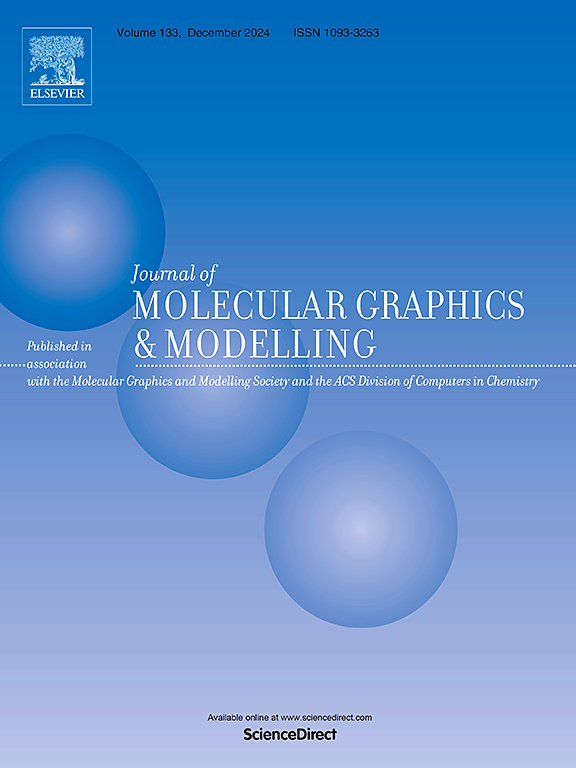Exploring phytochemicals and marine natural products as alternative therapeutic agents targeting phosphotransacetylase (PTA) in Mycobacterium tuberculosis: An underexplored drug target
IF 3
4区 生物学
Q2 BIOCHEMICAL RESEARCH METHODS
引用次数: 0
Abstract
Tuberculosis (TB), caused by Mycobacterium tuberculosis (MTB), remains a significant global health threat due to its widespread prevalence and increasing drug resistance. This study targets phosphotransacetylase (PTA), an essential enzyme in acetate metabolism, as a potential therapeutic target. A comprehensive multi-tiered virtual screening approach was employed to identify potent phytochemicals and marine natural products (MNPs) from five databases (AMMPDB, CMNPD, MNPD, Seaweed and SPECS). Five promising bioactive molecules (AMMPDB10473, CMNPD23347, CMNPD5918, MNPD6660, and SPECS-AK-693) were identified, showing high docking scores (−8.17 to −10.83 kcal/mol) and MM-GBSA binding energy scores (−47.51 to −59.14 kcal/mol). These molecules adhered to Lipinski's rule of five (Ro5) and demonstrated acceptable pharmacokinetic profiles. Density functional theory (DFT) calculations further validated the interaction potential of these molecules through HOMO and LUMO analysis. Long-range molecular dynamics simulations (MDS) over 300 ns confirmed the structural stability and enhanced hydrogen-bonding potential of the natural products-PTA complexes. Principal component analysis (PCA) and free energy landscape (FEL) contour plots revealed a single dominant energy basin, indicating structural stability and limited conformational flexibility of the complexes. Additionally, MMPBSA analysis corroborated the strong binding affinities of the identified hit molecules with PTA. Critical 'hot spot' residues (Phe516, Cys530, Ala531, and Tyr639) were identified, contributing significantly to the structural stability and binding energy of the complexes. This computational study offers valuable insights into the potential of these lead molecules for combating TB, providing a foundation for experimental validation and innovative therapeutic development, and paving the way for future research and breakthroughs in TB treatment.

探索植物化学物质和海洋天然产物作为替代治疗药物靶向磷酸化乙酰化酶(PTA)结核分枝杆菌:一个未开发的药物靶点
由结核分枝杆菌(MTB)引起的结核病,由于其广泛流行和耐药性增加,仍然是一个重大的全球健康威胁。本研究将磷酸酯转乙酰酶(PTA)作为潜在的治疗靶点。采用综合的多层虚拟筛选方法,从5个数据库(AMMPDB、CMNPD、MNPD、Seaweed和SPECS)中鉴定出有效的植物化学物质和海洋天然产物(MNPs)。5个具有生物活性的分子(AMMPDB10473、CMNPD23347、CMNPD5918、MNPD6660和SPECS-AK-693)具有较高的对接分数(- 8.17 ~ - 10.83 kcal/mol)和MM-GBSA结合能分数(- 47.51 ~ - 59.14 kcal/mol)。这些分子符合利平斯基的五定律(Ro5),并表现出可接受的药代动力学特征。密度泛函理论(DFT)计算通过HOMO和LUMO分析进一步验证了这些分子的相互作用势。超过300 ns的远程分子动力学模拟(MDS)证实了天然产物pta配合物的结构稳定性和增强的氢键电位。主成分分析(PCA)和自由能景观(FEL)等高线图显示了单一的优势能量盆地,表明配合物的结构稳定性和有限的构象灵活性。此外,MMPBSA分析证实了鉴定的击中分子与PTA的强结合亲和力。关键“热点”残基(Phe516、Cys530、Ala531和Tyr639)被鉴定出来,对复合物的结构稳定性和结合能有重要影响。这项计算研究为这些先导分子在防治结核病方面的潜力提供了有价值的见解,为实验验证和创新治疗开发奠定了基础,并为结核病治疗的未来研究和突破铺平了道路。
本文章由计算机程序翻译,如有差异,请以英文原文为准。
求助全文
约1分钟内获得全文
求助全文
来源期刊

Journal of molecular graphics & modelling
生物-计算机:跨学科应用
CiteScore
5.50
自引率
6.90%
发文量
216
审稿时长
35 days
期刊介绍:
The Journal of Molecular Graphics and Modelling is devoted to the publication of papers on the uses of computers in theoretical investigations of molecular structure, function, interaction, and design. The scope of the journal includes all aspects of molecular modeling and computational chemistry, including, for instance, the study of molecular shape and properties, molecular simulations, protein and polymer engineering, drug design, materials design, structure-activity and structure-property relationships, database mining, and compound library design.
As a primary research journal, JMGM seeks to bring new knowledge to the attention of our readers. As such, submissions to the journal need to not only report results, but must draw conclusions and explore implications of the work presented. Authors are strongly encouraged to bear this in mind when preparing manuscripts. Routine applications of standard modelling approaches, providing only very limited new scientific insight, will not meet our criteria for publication. Reproducibility of reported calculations is an important issue. Wherever possible, we urge authors to enhance their papers with Supplementary Data, for example, in QSAR studies machine-readable versions of molecular datasets or in the development of new force-field parameters versions of the topology and force field parameter files. Routine applications of existing methods that do not lead to genuinely new insight will not be considered.
 求助内容:
求助内容: 应助结果提醒方式:
应助结果提醒方式:


